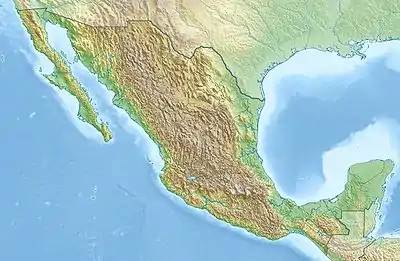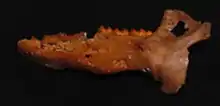Sistema Ox Bel Ha
Sistema Ox Bel Ha (from Mayan meaning "Three Paths of Water"; short Ox Bel Ha) is a cave system in Quintana Roo, Mexico. It is the longest explored underwater cave in the world[1] and ranks fourth including dry caves.[2] As of May 2017 the surveyed length is 270.2 kilometers (167.9 mi) of underwater passages.[1] There are more than 140 cenotes in the system.[3]
| Sistema Ox Bel Ha | |
|---|---|
 Sistema Ox Bel Ha Location in Mexico | |
| Location | Quintana Roo, Mexico |
| Coordinates | 20°9′37″N 87°29′15″W |
| Depth | 57.3 m (188 ft)[1] |
| Length | 270.17 km (167.88 mi)[1] |
| Discovery | February 1996 |
| Geology | Limestone |
| Entrances | 143 Cenotes[1] |
| Difficulty | Advanced cave diving |
| Cave survey | Grupo de Exploración Ox Bel Ha |
Discoveries
The Naranjal subsystem is part of Sistema Ox Bel Ha. Three prehistoric human remains have been found within the subsystem. The Jailhouse cenote, or Las Palmas, is the entrance to the locations of the Muknal and Las Palmas caves. The skeleton of an 18 to 20-year-old woman, Eve of Naharon, (13,454±117 cal BP) was discovered at a location around 368 m (1,207 ft) away from the Jailhouse cenote entrance. The skeleton of a 44 to 50-year-old woman, Las Palmas Lady (8,937±203 cal BP) was found at a location around 2 km (1.2 mi) away from the Jailhouse cenote entrance. The Muknal cave, part of the Naranjal subsystem, contained the remains of a 40 to 50-year-old man, the Muknal Grandfather (9,600 cal BP). Unlike the other two skeletons in the subsystem, the Muknal Grandfather shows evidence of secondary burial. Analysis of these skeletons suggests that Ox Bel Ha was likely used as an important site for ritual burial.[3]

A new genus and species of extinct peccary, Muknalia minima, was identified from a fossil mandible found in the Muknal cave of the Ox Bel Ha system.[4] However, it was subsequently recognised that this was a junior synonym of the collared peccary.[5]
See also
External links
References
- "List of Long Underwater Caves in Quintana Roo Mexico". Quintana Roo Speleological Survey. National Speleological Society (NSS). May 1, 2017. Retrieved May 26, 2017.
- Bob Gulden (November 28, 2016). "Worlds longest caves". Geo2 Committee on Long and Deep Caves. NSS. Retrieved May 26, 2017.
- Stinnesbeck, Sarah R; Stinnesbeck, Wolfgang; Terrazas Mata, Alejandro; Avilés Olguín, Jerónimo; Benavente Sanvicente, Martha; Zell, Patrick; Frey, Eberhard; Lindauer, Susanne; Rojas Sandoval, Carmen; Velázquez Morlet, Adriana; Acevez Nuñez, Eugenio; González González, Arturo (2018-09-05). "The Muknal cave near Tulum, Mexico: An early-Holocene funeral site on the Yucatán peninsula". The Holocene. SAGE Publications. 28 (12): 095968361879812. doi:10.1177/0959683618798124. ISSN 0959-6836. S2CID 134790516.
- Stinnesbeck, Sarah R.; Frey, Eberhard; Stinnesbeck, Wolfgang; Avíles Olguín, Jeronimo; Zell, Patrick; Terrazas Mata, Alejandro; Benavente Sanvicente, Martha; González González, Arturo; Rojas Sandoval, Carmen; Acevez Nuñez, Eugenio (2017). "A new fossil peccary from the Pleistocene-Holocene boundary of the eastern Yucatán Peninsula, Mexico". Journal of South American Earth Sciences. Elsevier BV. 77: 341–349. doi:10.1016/j.jsames.2016.11.003. ISSN 0895-9811.
- Schubert, Blaine W.; Samuels, Joshua X.; Chatters, James C.; Arroyo-Cabrales, Joaquin (2020-07-16). "Muknalia minima from the Yucatán of Mexico is synonymous with the collared peccary, Pecari tajacu (Artiodactyla: Tayassuidae)". Open Quaternary. 6 (1): 8. doi:10.5334/oq.84. ISSN 2055-298X.
Chetumal (capital) | |||||||||||
| Municipalities (seats) |
|  | |||||||||
| Places of interest |
| ||||||||||
| |||||||||||||||||||||||||||||||||||||
| |||||||||||||||||||||||||||||||||||||
| |||||||||||||||||||||||||||||||||||||
| |||||||||||||||||||||||||||||||||||||
| |||||||||||||||||||||||||||||||||||||
| |||||||||||||||||||||||||||||||||||||
| |||||||||||||||||||||||||||||||||||||
| |||||||||||||||||||||||||||||||||||||
| |||||||||||||||||||||||||||||||||||||
| |||||||||||||||||||||||||||||||||||||
| |||||||||||||||||||||||||||||||||||||
| |||||||||||||||||||||||||||||||||||||
| |||||||||||||||||||||||||||||||||||||
| |||||||||||||||||||||||||||||||||||||
| |||||||||||||||||||||||||||||||||||||